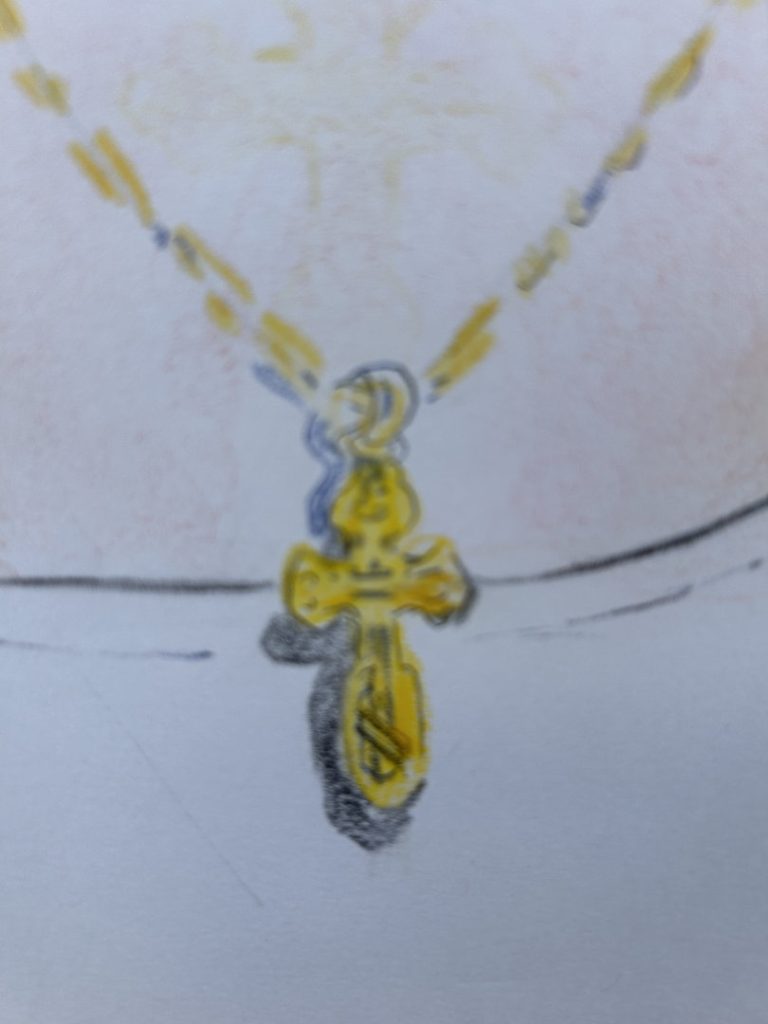⭐️This portrait of Maria was started in mid June, and completed mid July, 2024. I was looking at a lot of Russian watercolors and found the color saturation quite appealing for Maria’s lovely skin tones and hair, not to mention her brilliant hydrangeas in the background. A different approach, for sure, but one I am enjoying quite a bit and it worked out great! ⭐️
👨🏼🎨🎨
A few words concerning my process…
Oftentimes in painting, you have to make a tough decision: Whether to continue working on a piece, or to abandon it.
I know every artist deals with this at some point or another in their work, and the painstaking process can lead to frustration, anxiety and even sleepless nights.
One solution I have found: Best to wait until the mid tones and a shadow or two are in there before doing anything rash, and I do these early on so as to save even more time (they call this “blocking,” in the biz).
Blocking will let you see whether the big picture (pun 😊) has any appeal, and seeing the work in big blocks of light, dark and mid tone compositions helps to sort things out fast.
Subsequently, I’ve abandoned very few canvases and drawings over the years.
Now, I wish to examine two of my favourite Master Painters who influenced this particular art… painters whose lives and work both have more than a little in common between them: The American Master John Singer Sargent, and an artist whose work can be viewed somewhat as his antecedent, The Great 19th Century Russian Master, Ilya Repin.
The parallels are striking.
John Singer Sargent
__________________
John Singer Sargent (January 12, 1856 – April 14, 1925) was an American expatriate artist, considered the "leading portrait painter of his generation" for his evocations of Edwardian-era-luxury.
Sargent created roughly 900 oil paintings and more than 2,000 watercolors, as well as countless sketches and charcoal drawings. His oeuvre documents worldwide travel, from Venice to the Tyrol, Corfu, Spain, the Middle East, Montana, Maine, and Florida.”
-Wikipedia
Sargent painted bankers, Royals, their heirs, socialites, war veterans, gypsies, street urchins, ingenues, beauty queens, matronly figures, and seemingly everyone in between, offering us a glimpse of the denizens great and small who inhabited the main thoroughfares and small corridors of that bygone, gilded age.
“John Singer Sargent was especially known for his luscious bravura brushwork which was based on the Carolus-Duran wet-on-wet technique of flowing blended strokes and soft edges.
The loose, painterly marks look careless up close but from a distance merge to create a deft portrait of the subject.”
-Wiki
One bit of wisdom I’ve learned from Sargent is to work quicker; it often greatly benefits the work. It can take time to appreciate the soft, unfinished edges when they appear. I find I have to resist the urge to tamp them down on the canvas.
It can also take some time to develop the confidence to be able to identify when just enough is good enough, meaning you can’t take a technique any farther without losing any more than you gain, and the realisation of this difference, striking the proper balance, is one of the great joys of painting.
There is so much more to learn from Sargent, this is certainly not my last blog discussing his work.
Ilya Repin
_________
Ilya Yefimovich Repin (July 24, 1844 – September 29, 1930) was a Ukrainian-born Russian painter who became one of the most renowned artists in Russia in the 19th century. His major works include Barge Haulers on the Volga (1873), Religious Procession in Kursk Province (1880–1883), Ivan the Terrible and His Son Ivan (1885); and Reply of the Zaporozhian Cossacks(1880–1891).
Repin is also known for the revealing portraits he made of the leading Russian literary and artistic figures of his time, including Mikhail Glinka, Modest Mussorgsky, Pavel Tretyakov, and especially Leo Tolstoy, with whom he had a long friendship.”
-Wiki
Similar to Sargent, Repin’s mother, a teacher, recognized his artistic talent early on, and supported Repin’s efforts to become a painter, which he did professionally by his late teens.
Repin left his small Ukrainian village early in life at 16, seeking wider opportunities for his prodigious talent.
Frequently associated with portraiture, landscape, religious, and genre painting, Repin won numerous prestigious awards, quickly establishing his reputation as an artist. Eschewing the university trained formalism of his European contemporaries and instead embracing the direct emotional simplicity of nature, Repin was known to pose his subjects in an interesting and captivating way. They never appear false or forced.
Repin suffered one setback in 1885 when his history portrait of Ivan the Terrible killing his own son in a rage caused a scandal, resulting in the painting being removed from exhibition. But this was followed by a series of major successes and new commissions.
This event bears some resemblance to Sargent’s Paris Salon scandal in 1888 with his scandalous portrait of “Madame X,” and similarly this piece made Sargent’s name in elite Parisian artistic circles.
Both painters were passionate about Realism and shunned modernity, only flirting with newer artistic developments such as Impressionism, while preferring to paint directly from nature, and it’s true character, not to the arid formalism of stale tradition.
Both artists “strove to attain verity of vision, and rendering the grip of the actual; the potency of things seen and sincerely recorded.” The nuance and layered facial sequences alone are a wonderful aspect of Repin’s work to behold.
With my latest canvas (“Maria”), I strive to embody the best qualities of both artists. For whether it be the direct, emotional style of Repin, or the whimsical abstract flourish of Sargent peppering his canvas with fascinating flourishes of grace notes, there is so much to glean from these two brilliant master painters of the past.
Art is truly wonderful.
Until next month!
Sincerely, Elias
☦️👨🏼🎨🎨







